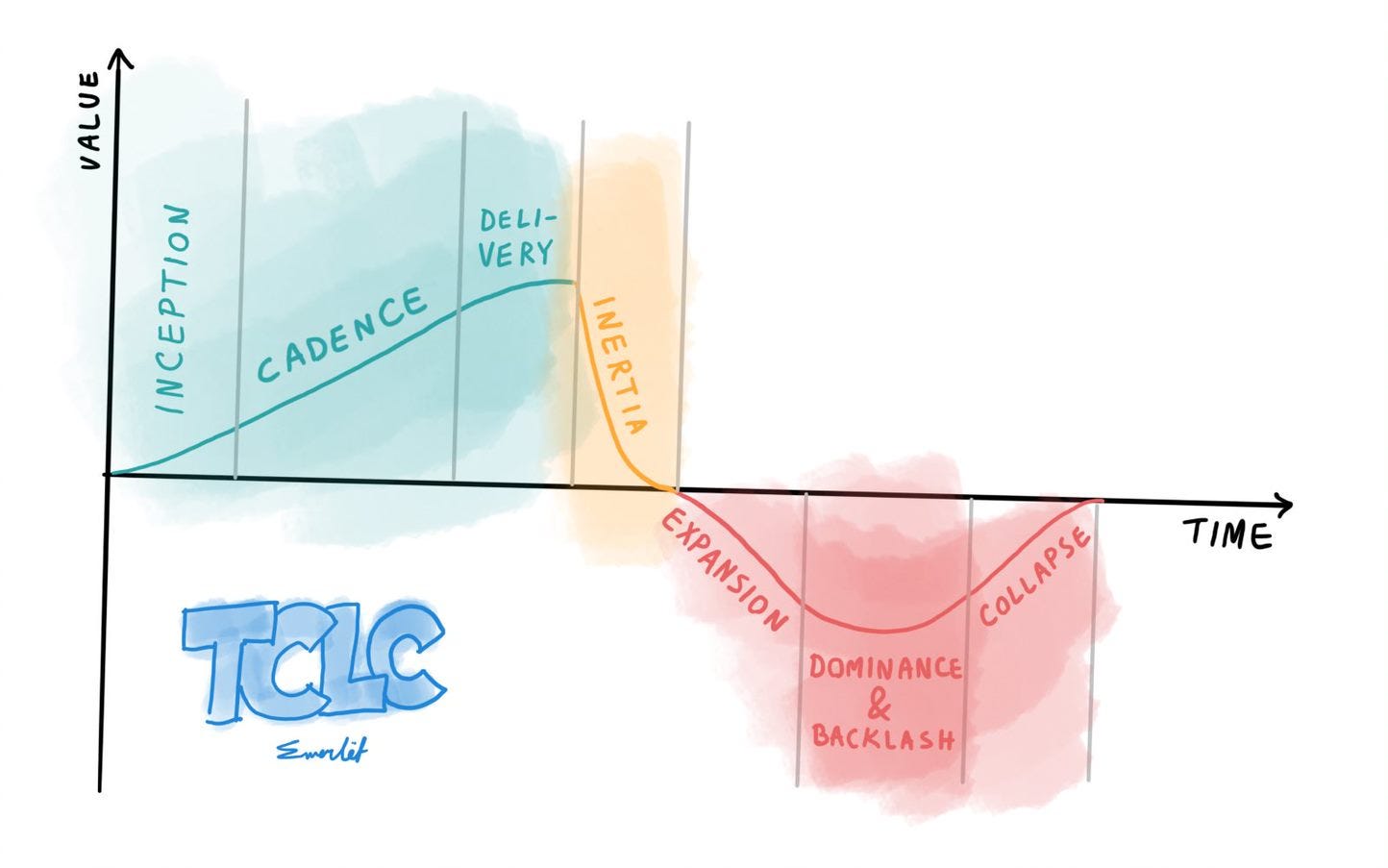Technical Committee Lifecycle
The lifecycle of technical committees and how they inevitably collapse
A while back I was asked to join a Technical Committee. 😲 I politely declined but my excuse became the core of this post.
This post briefly defines a Technical Committee and its lifecycle.
Technical Committee
Each company has their own flavor and nomenclature, but they usually share these elements:
Participants: high-ranking or vocal individuals from across the engineering organization (sometimes both)
Mandate: no formal mandate over product or people (as mentioned in another article, Staff Engineers fall into this category).
Agenda: architecture, tooling, process, standardization and technical challenges
Format: primarily meetings
The underlying idea is deceivingly easy to buy:
Delegating decisions to an expert group leads to better decisions.
In practice, however, it doesn’t deliver and sometimes even fights against that promise. Why? We will get to that, but first let’s dissect the lifecycle of a typical Technical Committee.
TCLC: Technical Committee Lifecycle
I have been to enough of these TCs at different companies to recognize a pattern:
Inception: it usually starts with a few people across the org realizing that they can solve a common problem more efficiently if they join forces.
Cadence: they meet a couple of times to coordinate the collaboration. Each meeting ends with an agenda due for the next one. It turns into a recurring meeting.
Delivery: the original objective is accomplished (or devolved). Many Committees stop and dismantle at this point. Some, however, don’t!
Inertia: Some Committees continue even after the delivery phase. This can happen due to the psychological dynamics that we’ll get into. At this stage, the cost of a recurring meeting is not justified by the value it provides but there’s inertia, so it continues.
Expansion: To keep the committee alive, it expands scope, recruits more people, and assimilates their mandate to the hive. Internally it feels like a grass-root movement on the rise. In reality, it’s about repurposing an expensive tool (recurring meetings with high-pay participants) for every problem. It may even emit some manifesto or generic vision and mission at this point.
Dominance & Backlash: Now that there's enough traction, the TC starts to demand important decisions to run through it. It acts as some sort of self-appointed government and may even generate data (usually through surveys) to justify its existence. What started as a tool to collaborate, is effectively abused to block other forms of collaboration. If the org has a healthy culture, there will be a backlash:
As it inevitably gets in the way, people call out its negative impact on performance
The org learns to work around the TC and render it irrelevant
The cabal’s existence may get escalated to the leadership
Collapse: Inevitably, the TC will collapse in one of these ways:
Management dismantles the “shadow leadership” group. In some cases, the original founders are let go. There will be hard feelings and martyrdom but it’s a good reminder that companies are governed more like medieval kingdoms than modern democracies.
It continues with a benign and made-up agenda without any impact beyond issuing manifestos, recommendations, and requests for comments. It is effectively harmless beyond wasting paid time.
Productive participants start to miss its meetings because they have more important things to do. The few who remain, mostly attending for the social aspects, have nothing better to do, or just show up due to FOMO (fear of missing out). Without enough participants, it fails to make any meaningful impact.
It pivots to something entirely different like a tech demo or community of practice. The idea is to recycle the participants and the scheduled meeting slot for something. Sky is the limit. At one company I saw this turning into a lunch meeting watching some “inspirational” videos on YouTube together. And who can say no to free lunch? 😄
Not all Committees follow that linear lifecycle. Some start in the middle. Some self-destruct as soon as the cost is larger than the value and people’s ego isn’t at stake. Some collapse even before a cadence is established. This type of recurring meeting is not exclusive to engineering. I’ve seen product, design, and leadership flavors. Although my main focus in this article is the Technical Committee, many points may apply to other disciplines as well.
How do I know this?
Because I have lost hundreds of hours at different companies to Technical Committees and was even naïve enough to run my own TC! 🤦♂️
I thought I have seen enough dysfunctional ones to run a functional one. I was wrong.
Turns out the solution feeds on the problem!
I was fortunate enough to get some honest and timely feedback and put an end to this misery. I’m quite proud of it actually. 😎 I’m not anti-collaboration, but I’m against waste.
We discovered more effective and efficient ways of collaborating, which will be introduced in a follow-up post.
I like to close this post with a quote from the man behind one of the most iconic cars in the history:
“Committees are, by nature, timid. They are based on the premise of safety in numbers; content to survive inconspicuously, rather than take risks and move independently ahead. Without independence, without the freedom for new ideas to be tried, to fail, and to ultimately succeed, the world will not move ahead, but rather live in fear of its own potential.” — Ferdinand Porsche
If you enjoyed this post, why not share it within your circles and social media to help make an impact? 🙌




> We discovered more effective and efficient ways of collaborating, which will be introduced in a follow-up post.
I couldn't fine the follow-up post. What's the alternative?